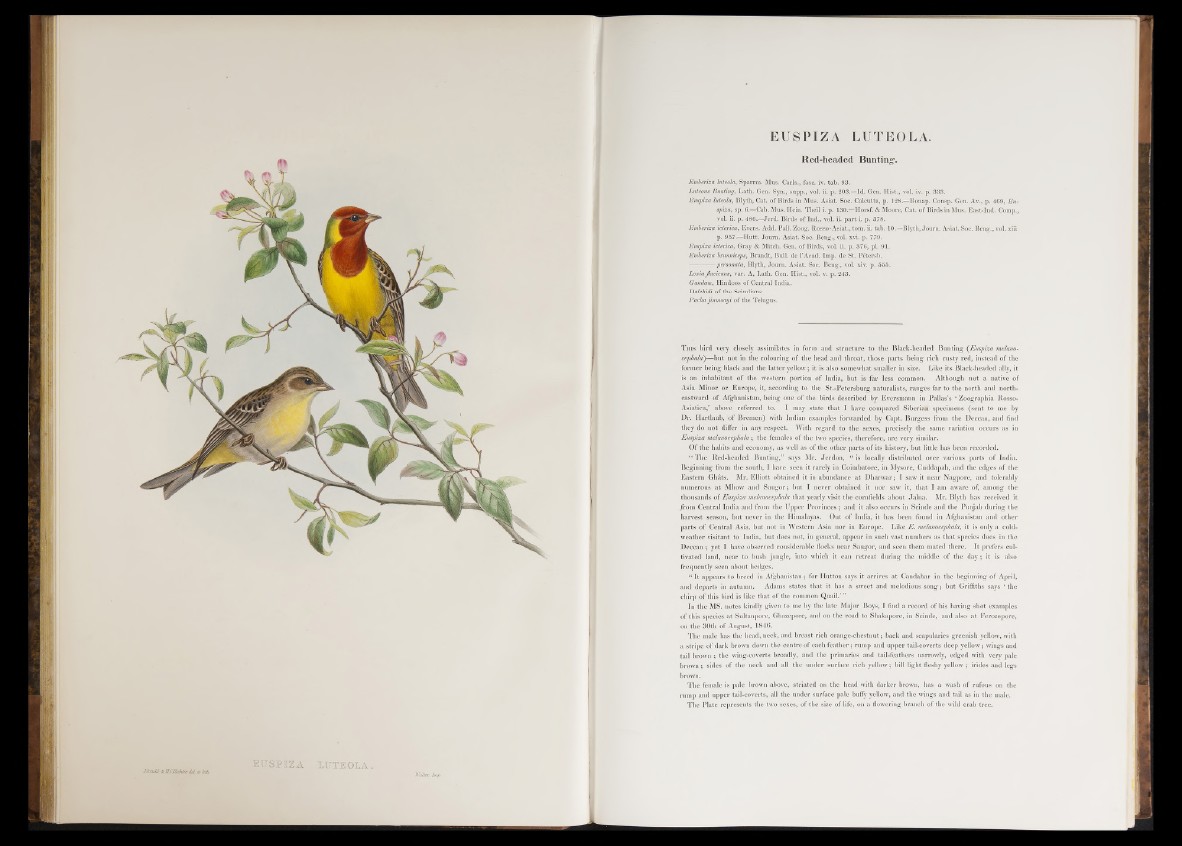
Stel
EUSPIZA LUTEOLA.
Red-headed Bunting*.
Emberiza luteola, Sparrm. Mus. Carls., fasc. iv. tab. 93.
Luteous Bunting, Lath. Gen. Syn., supp., vol. ii. p. 203.—Id. Gen. Hist., vol. iv. p. 333.
Euspiza luteola, Blyth, Cat. of Birds in Mus. Asiat. Soc. Calcutta, p. 128.—Bonap. Consp. Gen. Av., p. 469, Eu-
spiza, sp. 6.—Cab. Mus. Hein. Theil i. p. 130.—Horsf. & Moore, Cat. o f Birds in Mus. East-Ind. Comp.,
vol. ii. p. 486.—Jerd. Birds o f Ind., vol. ii. p a r t i. p. 378.
Emberiza icterica, Evers. Add. Pall. Zoog. Rosso-Asiat., tom. ii. tab. 10.—Blyth, Journ. Asiat. Soc. Beng., vol. xiii
p. 957.—H u tt. Journ. Asiat. Soc. Beng., vol. xvi. p. 779.
Euspiza icterica, Gray & Mitch. Gen. of B irds, vol. ii. p. 376, pi. 91.
Emberiza brunniceps, Brandt, Bull, de l’Acad. Imp. de St. Petersb.
personata, Blyth, Joura. Asiat. Soc. Beng., vol. xiv. p. 555.
LoxiaJlavicans, var. A, Lath. Gen. Hist., vol. v. p. 243.
Gandam, Hindoos o f Central India.
Dalchidi of th e Scindians.
Pacha jinmoayi of the Telugus.
T h i s bird, very closely assimilates in form and structure to the Black-headed Bunting (Euspiza melanocephala')—
but not in the colouring of the head and throat, those parts being rich rusty red, instead of the
former being black and the latter yellow; it is also somewhat smaller in size. Like its Black-headed ally, it
is an inhabitant of the western portion of India, but is far less common. Although not a native of
Asia Minor or Europe, it, according to the St.-Petersburg naturalists, ranges far to the north and northeastward
of Afghanistan, being one of the birds described by Eversmann in Pallas’s ‘ Zoographia Rosso-
Asiatica,’ above referred to. I may state that I have compared Siberian specimens (sent to me by
Dr. Hartlaub, of Bremen) with Indian examples forwarded by Capt. Burgess from the Deccan, and find
they do not differ in any respect. With regard to the sexes, precisely the same variation occurs as in
Euspiza melanocephala; the females of the two species, therefore, are very similar.
Of the habits and economy, as well as of the other parts of its history, but little has been recorded.
“ The Red-headed Bunting,” says Mr. Jerdon, “ is locally distributed over various parts of India.
Beginning from the south, I have seen it rarely in: Coimbatore, in Mysore, Cuddapah, and the edges o f the
Eastern Ghats. Mr. Elliott obtained it in abundance a t Dharwar; I saw it near Nagpore, and tolerably
numerous at Mhow and Saugor; but I never obtained it nor saw it, that I am aware of, among the
thousands of Euspiza melanocephala that yearly visit the cornfields about Jalna. Mr. Blyth has received it
„from Central India and from the Upper Provinces; and it also occurs in Scinde and the Punjab during the
harvest season, but never in the Himalayas. Out of India, it has been found in Afghanistan and other
parts o f Central Asia, but not in Western Asia nor in Europe. Like E. melanocephala, it is only a cold-
weather visitant to India, but does not, in general, appear in such vast numbers as that species does in the
Deccan ; yet I have observed considerable flocks near Saugor, and seen them mated there. It prefers cultivated
land, near to bush jungle, into which it can retreat during the middle of the d a y ; it is also
frequently seen about hedges.
“ It appears to breed in Afghanistan ; for Hutton says it arrives at Candahar in the beginning o f April,
and departs in autumn. Adams states that it has a sweet and melodious so n g ; but Griffiths says ‘ the
chirp of this bird is like that of the common Quail.” ’
In the MS. notes kindly given to me by the late Major Boys, I find a record of his having shot examples
of this species a t Sultanpore, Ghazepore, and on the road to Shakapore, in Scinde, and also a t Ferozepore,
on the 30th of August, 1846.
The male has the head, neck, and breast rich orange-chestnut; back and scapularies greenish yellow, with
a stripe of dark brown down the centre of each feather; rump and upper tail-coverts deep yellow; wings and
tail brown ; the wing-coverts broadly, and the primaries and tail-feathers narrowly, edged with very pale
brown; sides of the neck and all the under surface rich yellow; bill light fleshy yellow; irides and legs
brown.
The female is pale brown above, striated on the head with darker brown, has a wash of rufous on the
rump and upper tail-coverts, all the under surface pale huffy yellow, and the wings and tail as in the male.
The Plate represents the two sexes, of the size of life, on a flowering branch of the wild crab tree.